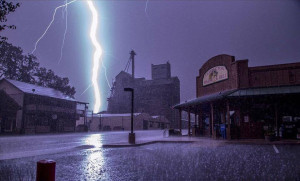Be prepared for winter storms

Helpful tips for homeowners and business owners
–It’s time to get ready for this season’s winter storms. While Templeton residents did not experience the rains forecasted in the 2015-2016 rainy season, winter storms should not be discounted. During past “big” rain years, Toad Creek has crested the Las Tablas and Florence Street bridges.
For those living or doing business in a frequently-flooded area, and also for those that may not, the following steps are recommended:
• For houses located in the path of runoff, keep plywood, plastic sheeting, and lumber on hand to divert.
• If the property can be protected by sandbags, consider getting sand and bags before the rainy season and stockpile as many filled bags as needed. Complimentary sand is available for Templeton residents; the sand is located on the corner of Old County Road and Florence Street. To collect the sand, bring a shovel and sandbags.
The following home improvement stores have sandbags available for purchase:
Hewitt’s Hardware: 428 S. Main St. in Templeton, Monday through Saturday, 8 a.m. to 9 p.m.
Orchard Supply Hardware: 2005 Theatre Drive in Paso Robles, Monday through Saturday, 8 a.m. to 9 p.m.
Home Depot: 905 El Camino Real in Atascadero, Monday through Saturday, 6 a.m. to 9 p.m.; Sunday 7 a.m. to 8 p.m.
Lowe’s: 2445 Golden Hill Road in Paso Robles, Monday through Saturday, 6 a.m. to 9 p.m.; Sunday, 7a.m. to 8 p.m.
In addition, the following steps are recommended:
• Inspect property for any signs of erosion – rain has a way of making small problems become big problems.
• Rake up and bag leaves as often as possible and especially before storms. Leaves tend to clog up the storm drain inlets and are a principal source of most flood occurrences.
• Clean all drains around the house, including roof gutters and downspouts, drain inlets and pipes, drainage ditches and driveway culverts before the rainy season and re-check between large storms.
During freezing weather, drip faucets to prevent broken water pipes. Drip both hot and cold water at faucets in kitchen and bathroom. This not only keeps water moving through the pipes, but relieves built-up water pressure in the pipes if they should freeze. Set single lever faucets in the center so both hot and cold lines drip.
• Make a plan and practice evacuation routes. Make a plan that includes information on the safest routes to shelters. Individuals living in flash flood areas should have several alternative routes. Keep all car and trucks fueled; if electric power fails, gas stations may not be able to operate.
Have personal comfort disaster supplies on hand at home and work:
• Flashlights and extra batteries
• First aid kit and manual
• Portable, battery-operated radio and extra batteries
• Non-electric can opener
• Emergency food (consider special diets) and water
• Essential medicines
• Warm clothing and/or blankets
• Sturdy shoes
• Cash and credit cards; if electric power fails, so do ATM’s
Make sure to prepare pets as well:
• Have a supply of food and water for pets
• Make sure pets have a collar and id tags that are up-to-date.
• Remember the average person that finds a pet won’t be able to scan for a chip but can read a basic identification tag.
• The chances of being reunited with lost pets increase when they have been microchipped; make sure the microchip registration has pet-owner’s name and current contact information.
Develop an emergency communication plan:
• Family members may become separated from one another during floods; have a plan for getting back together.
• Ask an out-of-state relative or friend to serve as the “family contact.”
• After a disaster, it’s often easier to call long distance; make sure everyone in the family knows the name, address, and phone number of the contact person.
• Teach children how and when to call 911, the police and fire departments, and which radio station to tune to for emergency information.









